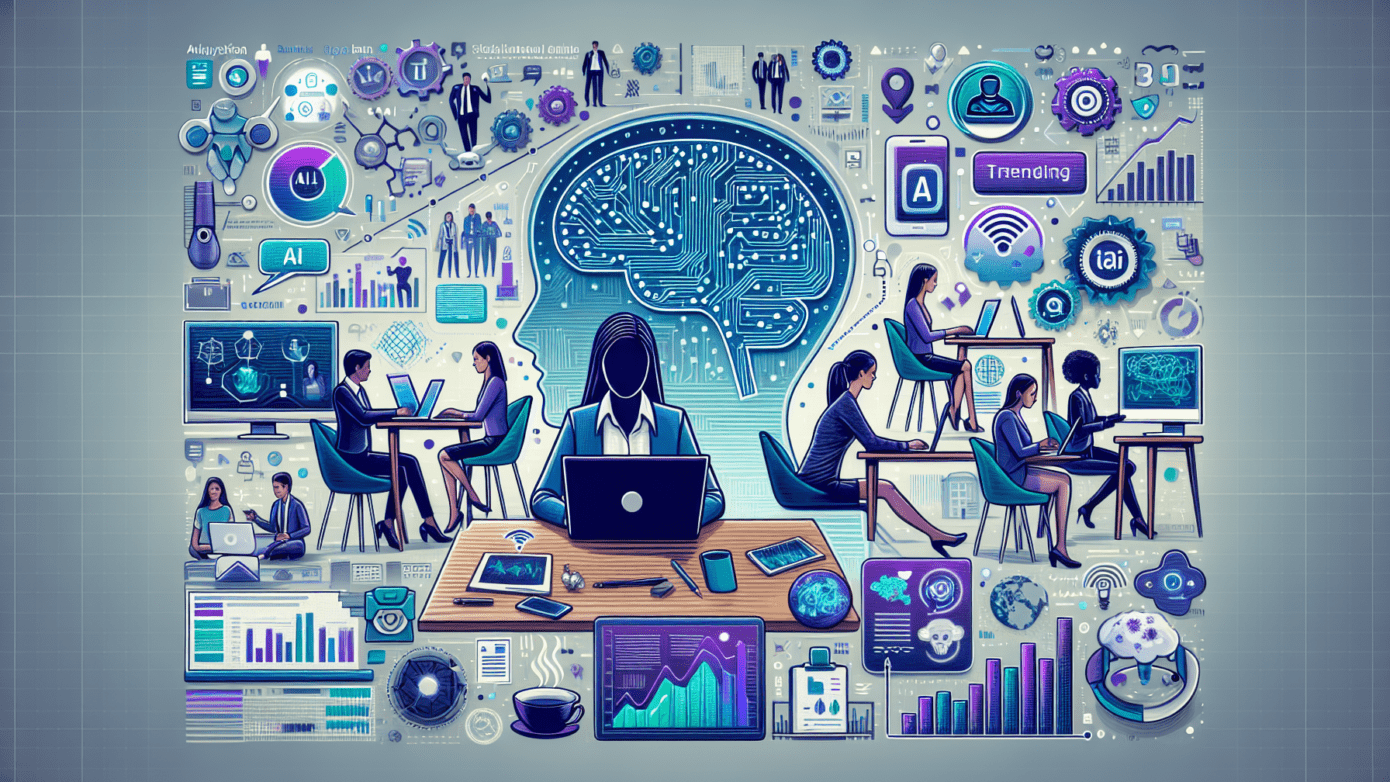As a solopreneur, you juggle many tasks daily. Marketing your brand can feel overwhelming. That’s where AI tools for digital marketing come in. These smart tools can help you analyze data and automate your tasks. Picture this: a chatbot chats with your customers 24/7, or an AI engine boosts your sales by predicting trends.
In fact, a popular fashion brand increased sales by 30% using data analysis. Exciting, right? In this guide, I’ll show you how AI can transform your marketing game. From picking the best tools to real-world examples, let’s dive deep into the world of AI. It’s time to empower your business and tap into new strategies!
Understanding AI in Digital Marketing: A Game Changer
What is AI in Marketing?
Artificial Intelligence (AI) encompasses a suite of technologies capable of performing tasks that traditionally require human intelligence. In marketing, AI leverages algorithms and data analytics to facilitate insights, predictions, and automation, thereby enhancing marketing strategies. Chatbots exemplify AI’s application by delivering instantaneous customer service, ensuring inquiries are addressed 24/7. Additionally, recommendation systems, like those utilized by platforms such as Netflix or Amazon, harness customer data to offer personalized product suggestions, driving engagement and conversions.
Recent developments in the AI sector have introduced tools that further enhance these capabilities. For instance, platforms like ChatGPT for customer interaction and personalized responses, or Cognifai for tailored product recommendations, provide marketers with robust solutions for deeper consumer engagement. Using these tools, marketers can manage customer interactions efficiently while delivering highly personalized content that resonates with individual preferences.
Why Use AI Tools for Data-Driven Marketing?
Incorporating AI tools in digital marketing offers numerous advantages that significantly enhance operational efficiency and decision-making. One of the foremost benefits is their capacity for rapid and comprehensive data analysis. AI tools can sift through colossal datasets, identifying trends and consumer preferences far faster than any traditional methods could accomplish. For example, a small e-commerce business might use tools like Power BI to analyze consumer behavior patterns, leading to a swift adjustment in inventory management and promotional strategies.
Moreover, AI-driven insights facilitate better decision-making processes. By interpreting data intelligently, AI tools enable marketers to understand not only what products are popular but also to forecast future trends based on historical data. This predictive capability supports strategic marketing initiatives, with brands increasingly relying on platforms like Salesforce Einstein that integrate machine learning for accurate sales forecasts and customer insights. However, while AI tools offer substantial advantages, it’s essential to remain aware of potential challenges in implementation and data privacy standards to maximize their effectiveness.
Key Features of AI Tools for Digital Marketing
Data Analytics
Understanding customer data is at the forefront of effective digital marketing strategies, empowering businesses to make data-driven decisions. AI excels in this area by efficiently analyzing vast amounts of customer information to identify trends and patterns that can inform marketing strategies. For instance, FashionAI is a newly launched tool that leverages machine learning algorithms to interpret shopping behaviors and predict future purchasing trends. A prominent fashion retailer adopted FashionAI and reported a remarkable 30% increase in sales by aligning their inventory with consumer interests.
Predictive analytics is another key feature of AI tools that enables marketers to anticipate market trends and customer needs. Tools like Tableau, which recently integrated AI-driven predictive analytics, allow marketers to visualize potential future sales and consumer behaviors based on historical data. These insights not only inform product development but also guide marketing campaigns for enhanced relevance. Pros of these analytics systems include enhanced decision-making capabilities and increased sales conversions. However, potential cons include the risk of data privacy issues and reliance on data quality.
Content Creation & Personalization
The ability to generate optimized content is increasingly crucial for engaging today’s audiences. AI tools such as Writesonic have emerged to assist in this space. By utilizing natural language processing, Writesonic can generate high-quality blog posts, social media updates, and marketing copy tailored to specific audiences and platforms. This streamlined approach allows businesses to craft messages quickly that resonate with their target demographics.
Personalization is equally important; AI not only helps in generating content but also ensures that messages are tailored to individual user behaviors. Tools like Persado leverage AI-driven data insights to craft personalized marketing messages that adapt and evolve based on user interaction, leading to improved engagement rates. However, businesses must tread carefully, as excessive personalization can lead to privacy concerns if not handled transparently. The pros of these content generation and personalization tools include increased audience engagement and efficiency in content production. In contrast, potential downsides may involve the inherent risk of reliance on AI-generated content failing to replicate human creativity.
Top AI Tools for Digital Marketing
AI Tool 1: HubSpot
HubSpot serves as a comprehensive platform for data-driven email marketing and automation, perfect for any digital marketing strategy. Its robust CRM capabilities enable users to segment their audiences effectively, ensuring targeted messaging tailored to specific consumer needs. HubSpot’s predictive lead scoring uses machine learning to identify high-value leads, optimizing your sales efforts.
Practical Example: A boutique fitness studio utilized HubSpot’s analytics to track email open rates and re-engagement strategies, resulting in a significant 25% increase in open rates within three months. The tool’s A/B testing feature also allowed for the refinement of email content, enhancing user engagement further.
AI Tool 2: Hootsuite Insights
Hootsuite Insights acts as a powerful tool for social media monitoring and analytics, enabling marketers to gauge the effectiveness of their campaigns in real-time. The platform aggregates customer conversations, driving insights into sentiment analysis and market trends.
Case Study: A lifestyle brand doubled its user engagement by employing Hootsuite Insights, using it to adjust their content strategies based on social listening data. This not only strengthened community interaction but also improved overall brand perception.
AI Tool 3: Google Analytics with AI Features
Google Analytics has implemented machine learning capabilities that provide insightful data on user behaviors, transforming how businesses approach their marketing. Beyond just reporting traffic, it can highlight trends and customer journey mapping.
Example: A retail company noted a 20% increase in return on investment (ROI) after utilizing enhanced reporting features in Google Analytics. By focusing on the recommended actions from data extraction, they could target high-conversion demographics more effectively.
AI Tool 4: SEMrush
SEMrush stands out as an SEO powerhouse, equipped with a suite of tools that streamline keyword research and competitive analysis. Its content optimization features not only analyze SEO performance but also suggest improvements based on top-ranking pages.
Highlight: A startup, originally struggling to gain traction online, leveraged SEMrush to develop a robust SEO strategy that increased its web traffic by 300% in six months. The platform’s backlink checker also aided in established partnerships that helped amplify their reach.
AI Tool 5: Buffer
Buffer simplifies the complexities of content scheduling and engagement analytics, making it an essential tool for marketers. It allows users to plan social media posts in advance while providing insights on engagement metrics.
Real-World Example: A small blog experienced a 50% increase in social media engagement after implementing Buffer. By analyzing the best time to post and adjusting content style based on performance metrics, they maintained a consistent presence across various platforms.
These AI tools bring efficiency and data-driven strategies to the forefront of digital marketing, allowing businesses to make informed decisions that enhance their market reach and engagement. Each platform serves unique purposes, making it crucial for digital marketers to assess their specific needs and goals when selecting the best tools for their strategies.
Implementing AI Tools in Your Marketing Strategy
Choosing the right AI tool for your marketing strategy requires a systematic approach. Start by assessing your business needs. Identify the specific challenges you want to address, be it improving customer engagement, increasing conversion rates, or enhancing data analysis. For instance, if your goal is better customer insights, tools like Hootsuite Insights or Google Analytics can provide valuable data analytics and social media monitoring features.
Budget considerations also play a crucial role. Evaluate the potential return on investment (ROI) that different tools promise. For example, if a specific AI tool claims to increase lead generation, compare it against your operational costs and the projected number of additional customers acquired. This analysis helps you determine whether the expense aligns with your expected growth and profitability.
Once you’ve selected the appropriate AI tools, setting measurable objectives is essential. Clear and actionable goals enable you to track the effectiveness of these tools. For example, if you’re utilizing a content automation tool, specify the number of posts per week or the desired engagement level as benchmarks.
Continuous optimization is vital for long-term success. Regularly reviewing analytics allows you to refine your strategies based on solid data. Leveraging insights from tools such as SEMrush for SEO or Buffer for social media engagement can reveal content performance trends that inform future campaigns.
Recent trends indicate that marketers using AI tools see significant ROI, with studies showing up to a 35% increase in efficiency when responsive AI tools are employed. This is a clear indication that marketers who closely monitor their results and adjust their strategies accordingly can gain a competitive edge in today’s fast-paced digital landscape.
Challenges and Limitations of AI in Marketing
The integration of AI tools into digital marketing brings numerous advantages, but it’s important to acknowledge the inherent challenges that can arise. Understanding these obstacles not only helps marketers navigate their implementation effectively but also sets the stage for finding appropriate solutions.
Common Pain Points
Data Privacy Concerns:
As regulations like GDPR and CCPA tighten the grip on data handling, businesses must tread carefully when adopting AI tools. These regulations emphasize consumer data protection and require marketers to obtain explicit consent for data collection and usage. Failure to comply can result in hefty fines and damage to brand reputation. In the digital landscape, where consumer expectations around privacy are evolving rapidly, leveraging AI responsibly is crucial. For instance, a cookie-based tracking system for personalized content can be effective but poses risks if consumers’ willingness to share data diminishes.
Complex Integration:
Bringing AI tools into existing marketing systems can be a daunting task. Many businesses struggle with integrating diverse platforms that may not seamlessly work together. For example, an AI-driven analytics tool might clash with a legacy email marketing system, resulting in data silos and inefficiencies. Additionally, the learning curve associated with new tools can hinder performance if team members are not adequately trained. The complexity increases with the scale of operations, making it vital to evaluate the compatibility of new AI solutions with existing infrastructures.
Overcoming Challenges
Effective Implementation Tips:
A strategic approach to implementation can mitigate the challenges. Start by identifying a single area where AI can add value—like automating responses in customer service—and gradually expand its use. This incremental adoption allows for adjustments based on real-time feedback, thereby minimizing disruption. For instance, a business might pilot a chatbot to manage customer inquiries before rolling it out company-wide. Such a phased method not only reduces risks but also eases training demands on staff.
Balancing Efficiency with Human Intuition:
AI tools excel in data crunching and pattern recognition, but they cannot replace the nuanced understanding brought by human marketers. Thus, a blended approach is essential. While AI can analyze market trends, human creativity and intuition remain invaluable for crafting authentic messages. An example is how a brand might utilize AI-generated content for blogs while infusing personal stories and unique viewpoints from human writers. Striking this balance can elevate marketing efforts, ensuring campaigns remain relatable and connected to consumers’ emotions.
Additionally, it is important to remain informed about evolving regulations and trends in the AI landscape to adapt effectively while ensuring compliance and security. This proactive approach can help businesses harness the full potential of their digital marketing strategies.
The Future of AI in Digital Marketing
Emerging Trends
The landscape of digital marketing is rapidly evolving, with AI at the forefront of this transformation. One prominent trend is the increasing demand for hyper-personalization. Tools like Audience AI allow marketers to analyze extensive customer datasets to create tailored experiences for their audiences. This tool employs machine learning algorithms to segment users based on nuanced preferences, resulting in content recommendations that resonate on a personal level. While the potential of such technologies is vast, a successful implementation requires blending data insights with creative storytelling, ensuring that campaigns are not just effective in reach but also in resonance.
Another emerging trend is the advancement of conversational AI. Platforms such as Drift are redefining customer interactions by automating chat-based environments that engage visitors in real time and provide tailored responses based on user queries. This evolution streamlines communication while paving the way for more authentic brand-consumer relationships. However, integrating advanced AI chat functionalities necessitates a balance between automated interactions and human oversight to maintain brand voice and credibility.
Preparing for Change
To remain competitive in this dynamic environment, marketers must be adaptive to technological advancements. Regular training sessions and workshops focusing on AI literacy can enhance a team’s ability to harness these tools effectively. Subscription to industry newsletters or participation in webinars can keep marketers abreast of the latest AI innovations. Community platforms like Product Hunt allow users to discuss and review newly launched products, serving as a valuable resource to identify effective solutions in real-time.
Moreover, creating a culture of experimentation is crucial. Businesses should encourage teams to pilot new AI tools without the fear of failure. By testing various methods and tools like Jasper.ai for content generation or Canva’s new AI design features, businesses can innovate their approaches and glean actionable insights. Taking these preparatory steps can significantly enhance responsiveness to shifts in consumer behavior, ensuring brands remain relevant in an increasingly AI-driven market.
In conclusion, the future of AI in digital marketing is poised for substantial growth. With an ever-increasing focus on personalization and consumer engagement, marketers need to adapt proactively, prioritize continual learning, and foster a culture of innovation. Embracing these changes will not only enhance digital marketing strategies but will also cement a brand’s position in an evolving market landscape.
FAQs
What are the best AI tools for small businesses?
For small businesses, affordability alongside features is crucial when selecting AI tools. Noteworthy options include Mailchimp, which offers intelligent email marketing automation tailored to user behavior, and Canva, which provides AI-driven design features for social media graphics. Both tools come with user-friendly interfaces and free or low-cost plans, making them accessible. However, while powerful, Mailchimp’s pricing can escalate with increased subscribers, and Canva may have limitations in advanced functionalities unless upgraded.
How can AI improve my digital marketing campaign?
AI enhances digital marketing campaigns by delivering improved targeting and personalization. By analyzing user data and behavior, tools like AdEspresso enable marketers to create highly tailored ads that resonate more effectively with their audience. Furthermore, AI can optimize bidding strategies for paid media, allowing for more efficient ad spend. However, reliance solely on AI lacks emotional intelligence, and a human touch is still essential to create genuinely engaging content.
Are AI tools difficult to integrate into existing marketing systems?
The integration of AI tools can pose challenges, particularly when compatibility with existing systems is not straightforward. To ensure a smoother transition, businesses should first map out their workflow and identify key areas where AI will add value. Tools like Zapier can facilitate integration across multiple platforms with minimal coding needed, giving your marketing efforts the lift they require. It’s crucial to allocate resources for training and to start with one or two tools before expanding, avoiding an overwhelming shift.
What is the ROI of using AI tools in digital marketing?
The return on investment for AI tools is characterized by increased efficiency, cost reductions, and improved customer engagement. Studies have shown that companies employing AI-powered solutions can see a revenue growth of 10-20% annually due to better-targeted campaigns and automated processes. However, it’s essential to track KPIs to measure ROI accurately, as initial investments can be high, and outcomes often materialize over time rather than immediately.
How do I choose the right AI tool for my needs?
Selecting the appropriate AI tool starts with assessing your specific needs and objectives. Factors such as budget, scalability, available features, and user-friendliness should be considered. Comparing tools like HubSpot for its comprehensive marketing features against Hootsuite for social media management may provide clarity depending on your goals. Additionally, seeking peer reviews and trial versions of tools can help in making a more informed decision that aligns with your business strategies.
In this article, we explored the power of AI tools for digital marketing. AI helps analyze data, boosts decision-making, and automates tasks. Popular tools like HubSpot and SEMrush can drive major growth. Always assess your needs, set clear goals, and stay updated on trends.
As AI in marketing evolves, staying ahead matters. Consider starting small, blending AI innovation with your unique creativity. Dive deeper into the world of AI tools for digital marketing to transform your efforts. The future is bright, and the time to act is now!



Leave a Reply